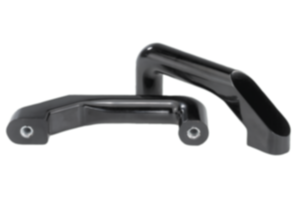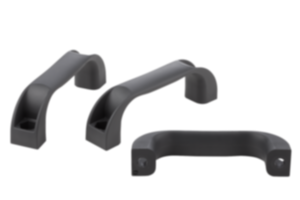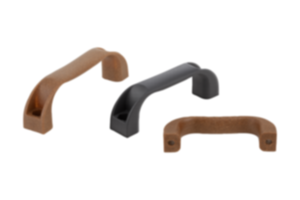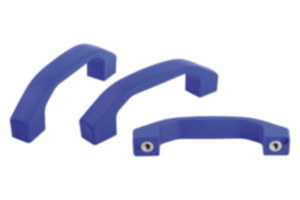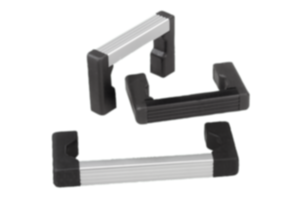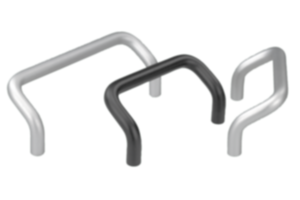Threaded spindles and plates
Plates for levelling and swivel feet
Plates for für levelling and swivel feet are widely used in many industrial sectors and applications. There, the operating parts are crucial for the stable and safe installation of machines and equipment.
Levelling feet are height-adjustable feet that make it possible to precisely adjust the height of an object. Swivel feet also offer flexible adjustment to uneven surfaces. Plates installed under such feet increase the contact face and contribute to stability and load distribution.
A swivel foot significantly improves functionality of levelling and swivel feet by making it easier to adjust to different floor conditions. This minimises the risk of damage to machines or floors and ensures safety in the working environment. To provide additional grip and further increase safety, swivel feet are also equipped with non-slip surfaces.
There are many possible applications for swivel feet. Industrially, they are often used under heavy machinery and production systems.
Due to their flexible adjustment to the surface, they prevent vibrations and movement. In other words, operating parts protect against damage or malfunctions. Swivel feet are also crucial in logistics, where shelves and storage containers have to sit firmly on uneven floors. The KIPP ranges includes 14 different plates. These differ mainly in terms of material, plate diameter, height and load rating. Plates for swivel feet made of stainless steel are corrosion-resistant, durable and hygienic. They are ideally suited for use:
- in the foodstuff industry
- in the medical field and
- in environments with high humidity.
Plates for levelling feet made of steel are sturdy and affordable. Swivel feet made of steel offer a high load-bearing capacity and are suitable for general industrial applications.
Plastic plates are light and corrosion resistant. Plates made of thermoplastic are affordable. They are used in low stress environments or in areas where weight reduction is important. Compared to metal plates however, they have a lower load-bearing capacity.
Plates for swivel feet made of zinc offer good corrosion protection at a comparatively low price. Zinc plates are more corrosion resistant than uncoated steel, but not as durable or strong as stainless steel. They are well suited for outdoor applications or in environments with moderate humidity.
What are swivel feet?
Swivel feet are often also referred to as machine foot, levelling foot or articulated foot. The plate is used in combination with levelling and swivel feet. It is used when machines or equipment are on uneven or inclined surfaces and need to stand stably. Swivel feet are made from robust materials such as steel or plastic. Swivel feet are the basis for swivel feet. Feet are made up of a plate and a threaded spindle or ball joint. Each plate by KIPP can be combined wit a spindle.
The basic functions of swivel feet are:
- Stabilisation: The larger contact face provided by the plate increases the stability of the object which is placed on it. This is particularly important for heavy machines or appliances.
- Load distribution: Swivel feet distribute loads affecting the object evenly across the ground, reducing intermittent stress and preventing damage to the floor.
- Vibration absorption: With some styles, swivel feet can also help to dampen vibrations and oscillations, which increases machine service life and operational safety. At KIPP, this is realised by the anti-slip plate made of thermoplastic elastomer.
A swivel foot is made up of several specific components. The basic parts of swivel feet are:
- Base plate: This is the flat, sturdy platform of the swivel foot that rests directly on the floor. It is often made of sturdy material such as steel or plastic in order to withstand the weight and loads.
- Fastener element: This part connects the rod end to the base plate and allows for flexible movement of the rod end. This can be a bolt, screw or other connecting part that holds the two main components together.
- Stud or levelling foot: The stud or levelling foot is often attached to the rod end. However, at KIPP you can purchase these two operating parts separately. That is how we ensure that you get products that fully meet your requirements. It is important to know that every levelling foot or stud can be combined with every plate.
- Non-slip coating and buffer elements: Some swivel feet have a non-slip coating or rubber pad on the base plate to provide additional grip and prevent slipping on smooth surfaces. In some versions, additional buffer elements are integrated to absorb vibrations and oscillations in order to further increase stability and reduce load on machines and floors.
The KIPP ranges includes two different swivel feet. These differ in vibration absorption. The plate diameters range from 20 mm to 60 mm and the load rating from 0.212 kN to 55 kN.
Advantages of swivel feet
Swivel feed and plates for levelling and swivel feet offer numerous advantages in different applications. Swivel feet allow for individual adjustment to uneven surfaces, whereby uneven surfaces may be levelled.
They offer improved stability, as they adjust to the inclination of the floor and thus ensure even load distribution.
In addition, swivel feet can absorb vibrations, making machines and devices run more stably and quietly. The improved load distribution prevents damage to the floor, as there are no intermittent stress points.
Swivel fee are available in different materials and sizes, making them extremely versatile in use. That way operating parts may be adjusted to suite different requirements.
Plates for levelling and swivel feet allow for simple and precise hight adjustment of machines as well as devices, which is particularly advantageous in uneven environments.
Plates are often made of sturdy materials and can take heavy loads, making them perfect for heavy machinery and equipment.
What's more is that many plates are also made from corrosion resistant materials, which is extending their service life and making them suitable for use in damp or aggressive environments.
The design of the plates allows for quick and simple installation and easy replacement if required.
They increase safety as they stabilise machines and equipment. The parts also reduce the risk of the machines tipping over and shifting. The improved stability and durability of machines and devices can reduce maintenance and repair costs in the long term.
To summarise, swivel feet and plates for levelling and swivel feet a number of advantages that contribute to better stability, flexibility and durability of machines and devices.
KIPP: Your manufacturer of swivel feet
HEINRICH KIPP WERK GmbH & Co. KG is a leading manufacturer of standard elements and operating parts. We offer a wide range of products that are characterised by high quality and reliability. KIPP's special products include plates for levelling and swivel feet as well as swivel feet, which are crucial in different industrial applications.


